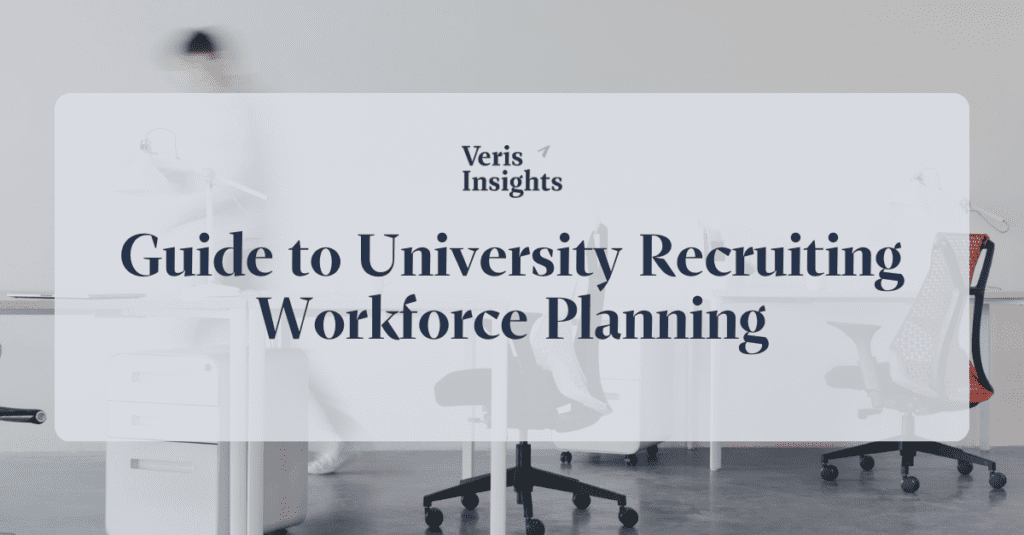April 05, 2023
Strategic Workforce Planning: Build a Proactive University Recruiting Strategy
Despite the immense value of proactive workforce planning, implementing a long-term hiring strategy feels out of reach for many University Recruiting teams. Our employer benchmarking research found that a staggering 94% of UR teams reported late requisitions as a challenge in 2022, and that a quarter of teams forecast UR hiring volume just six months or less into the future. Forecasting hiring needs ahead of time is valuable for University Recruiting teams and for the business more broadly, but it might require a shift from a reactive workforce planning model to a proactive approach.
Before you start changing your approach to workforce planning, it’s helpful to understand the type of approach you currently take. The most reactive approach is when stakeholders send the UR team requisitions as needed. A more neutral strategy is when UR teams survey business lines on entry-level needs to plan six months to a year in advance. The most proactive approach is when UR teams gather data and align hiring plans with the future business goals; the team presents business leaders with models, advises on overall strategy, and iterates based on feedback.
In reactive workforce planning strategies, UR teams address needs as they arise, which hinders long-term planning. Proactive strategies allow planning for future pipelines and position the UR team as central in building long-term sustainable vision. Here are three steps you can take to empower your UR team to move from being requisition fillers to being strategic partners.
Download the Guide to University Recruiting Workforce Planning
Step 1: Know Your Numbers
Gathering current metrics is key for accurately setting hiring goals. It’s important to consider key metrics going back two years or more, if possible, separated by business line.
These metrics could include:
- • Overall headcount across function
- • Target percentages of total headcount from entry-level talent
- • Entry-level turnover & attrition rate
- • Intern to full-time conversion rate
- • Average renege rate for interns, new full-time hires, and return full-time hires
- • Applicant acceptance rate
You know your business best, so if there are alternate factors that would more strongly influence your stakeholders, be sure to highlight those (cost per hire, cost to onboard/train, DEI metrics, growth projections, etc.).
Step 2: Engage Stakeholders to Formulate Your New Workforce Planning Model
Strong stakeholder buy-in facilitates smoother workforce planning conversation. Additionally, it helps business line leaders to understand why timelines for recruiting and budgeting may be misaligned, and it champions internships as a pipeline for talent instead of secondary to TA strategy.
When developing and empowering UR champions:
- • Identify individuals with a strong investment in your early talent program
- • Engage those individuals throughout your entire recruiting process
- • Share victories, success stories, and progress towards goals
- • Make the most of stakeholder expertise through direct student engagement (events, student groups, etc.)
- • Where possible, reward UR champions – recognition and visibility can show how highly you value their partnership
Step 3: Adopt a Long-Term Vision for Your Recruiting Strategy Plan
UR leaders can become strategic partners by moving beyond short-term operational functioning to long-term visions.
Questions for leadership:
- • What is the strategic vision for growth in the next 3 years?
- • What skills will be required to achieve these goals?
- • What type of talent will fuel long-term growth?
- • Are there specific regions/locations of highest importance?
University Recruiting as Strategic Partners
It’s important for UR teams to be seen by the rest of the business as a team that enables long-term growth, as opposed to a team that swoops in at the last second and delivers talent.
As one Head of Early Talent puts it:
“We’re just trying to educate our business because everybody is looking for just-in-time solutions and the spotlight is on us, but we are not a just-in-time solution, we’re more a long haul solve.
In our industry, it’s always just ‘get your 100 interns here,’ and we’re like, well, that doesn’t work anymore. We really need to think about conversion and filling the pipeline. So we’re getting, for the first time ever, into workforce planning with our HR business partners. This really requires educating our client on when and what we can deliver in terms of an internship and full-time program.”
Becoming a strategic partner instead of a requisition filler requires UR teams to take a strategic and multifaceted approach, but will have a significantly positive impact on the business as a whole.
Download the Guide to University Recruiting Workforce Planning.
